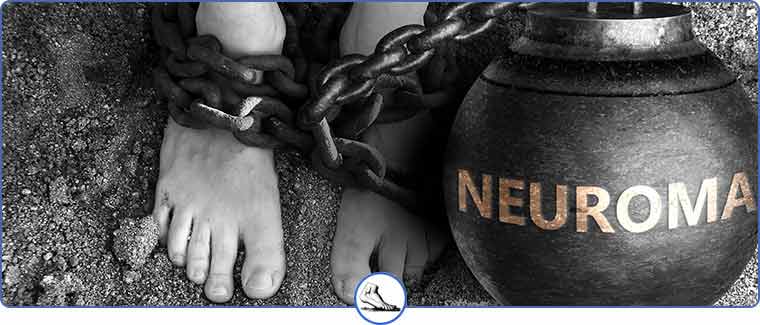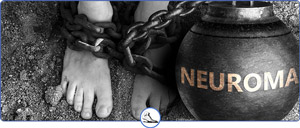Neuroma Treatment Specialist Q&A
A neuroma is a benign growth of nerve tissue that often forms between the toes, commonly referred to as Morton’s neuroma. This condition typically occurs between the third and fourth toes and can lead to symptoms such as sharp, burning pain, numbness, or the sensation of a lump in the foot. If you are experiencing these symptoms, consult Dr. John W. Scivally, DPM, and Dr. Robin K. Lie, DPM for an accurate diagnosis and effective treatment options. For more information, contact us or schedule an appointment online. We have convenient locations to serve you in Walnut Creek CA, and Brentwood CA.


Table of Contents:
What kind of doctor treats neuroma?
What is a Neuroma?
What Causes Neuromas?
How is a Neuroma Diagnosed?
How is a Neuroma Treated?
Neuroma, or Morton’s neuroma, affects the ball of the foot, usually between the third and fourth toe. It is a painful condition that can make your foot feel as if you have a pebble in your shoe or that there is a fold in your sock that is pushing on the bottom of your foot. Your family doctor can perform the initial exam and provide a diagnosis and treatment plan, depending on the severity of the neuroma. You may also get referred to a podiatrist, who is a doctor that specializes in disorders of the foot, or a foot surgeon if your doctor thinks that surgery might be the only option for treatment.
A neuroma is a painful affliction in the foot that occurs on the ball of the foot, typically between the third and fourth toe. It is caused by a thickening of some of the tissue surrounding a nerve connected to the toes. A neuroma can create a sharp, burning pain centered in the ball of the foot. You may also experience sensations of burning, stinging or feeling numb in the toes. The feeling of a neuroma is often compared to the feeling of having a small pebble in your shoe that you are constantly stepping in, or the feeling of have a sock folded inside of your shoe and stepping on the fold.
Neuromas seem to be the result of pressure, irritation or an injury in the nerves that connect to your toes. The likelihood of developing a neuroma can increase with the wearing of high-heeled shoes, being involved in certain high-impact sports or athletic activities or deformities of the foot. Wearing proper fitting shoes can have an impact on your neuroma symptoms. High-heeled shoes, as well as shoes that don’t fit properly can put additional pressure on the ball of the foot and the toes. Sports and athletic activities that involve high impact on your feet such as running, or where you are wearing tight shoes can contribute to neuroma. Existing foot conditions such as bunions, hammertoes, flat feet or high arches also put individuals at a higher risk of neuroma.
To determine the presence of a neuroma, your doctor or podiatrist will first perform a physical exam on the foot to find a tender spot or an unknown mass that can be found by pressing on the foot in various spots. A neuroma may also cause a “clicking” feeling in your foot, between the bones. Your doctor may also want to perform some imaging tests on your foot to confirm a diagnosis of neuroma and rule out other potential causes. An X-ray is a common test that is ordered to see the bones of the foot and rule out something like a stress fracture as the cause of the pain. An ultrasound is better at showing abnormalities in the soft tissues, including neuromas. An MRI can also be used to diagnose a neuroma, but it is expensive.
There are different ways to treat a neuroma, depending on the severity of the symptoms being experienced. Most doctors will try a conservative approach before moving to more extreme measures such as surgery. The common initial treatment option would be foot pads and arch supports. These fit inside of your shoe and are used to help reduce the pressure placed on the nerve. They are readily available over the counter at a drug store, or you can have them custom-made to match your foot’s exact contours. If these initially treatments don’t work, there are more advanced treatments available. These include injections of steroids into the area that is experiencing pain, decompression surgery to relieve pressure on the nerve. If all else fails to provide relief from the pain, the affected nerve can be surgically removed. While it is usually a successful surgery, there is a risk of causing permanent numbness to the affected toes.
If you need Neuroma treated, then we encourage you to contact our team of medical professionals today at Bay Area Foot and Ankle Associates. We care about your health and well-being. For more information, contact us or schedule an appointment online. We have convenient locations to serve you in Walnut Creek CA, and Brentwood CA. We serve patients from Walnut Creek CA, Brentwood CA, Concord CA, Pleasant Hill CA, Pittsburg CA, Antioch CA, Alamo CA, Danville CA, and Oakley CA.

Additional Services You May Need
▸Custom Foot Orthotics
▸Ingrown Toenail Specialist
▸Traditional Podiatry Care
▸Foot and Ankle Surgery Clinic
▸Bunion Doctor
▸Corns and Calluses
▸Foot Arthritis and Joint
▸Warts
▸Video Gait Analysis
▸Athletic Taping
▸Pediatric Foot Specialist
▸Gait Abnormalities
▸Foot Dermatologist
▸Foot Deformities
▸Chronic Foot Injury
▸Diabetic Foot Specialist
▸Acute Foot Injuries
▸Podiatric Sports Services
▸Plantar Fasciitis Specialists


